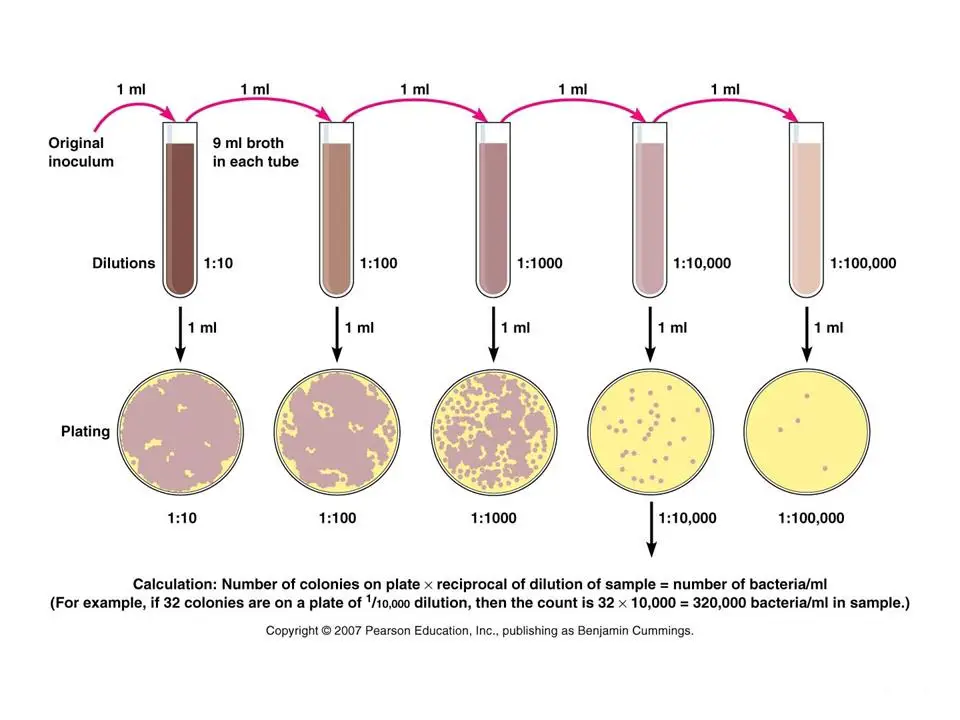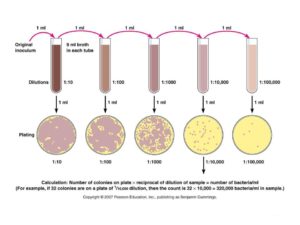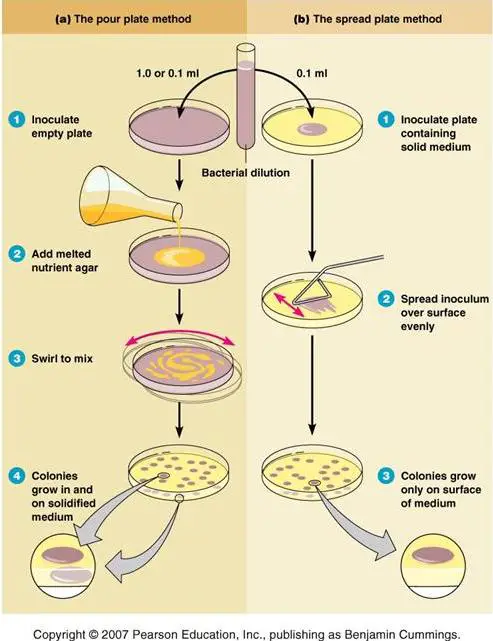Pour plate Method: Principle, Procedure, Uses, and (Dis) Advantages

Pour plate method is usually the method of choice for counting the number of colony-forming bacteria present in a liquid specimen. In this method, fixed amount of inoculum (generally 1 ml) from a broth/sample is placed in the center of sterile Petri dish using a sterile pipette. Molten cooled agar (approx. 15mL) is then poured into the Petri dish containing the inoculum and mixed well. After the solidification of the agar, the plate is inverted and incubated at 37°C for 24-48 hours.
Microorganisms will grow both on the surface and within the medium. Colonies that grow within the medium generally are small in size and may be confluent; the few that grow on the agar surface are of the same size and appearance as those on a streak plate. Each (both large and small) colony is carefully counted (using magnifying colony counter if needed). Each colony represents a “colony forming unit” (CFU).
The number of microorganisms present in the particular test sample is determined using the formula:
CFU/mL= CFU * dilution factor * 1/aliquot
For accurate counts, the optimum count should be within the range of 30-300 colonies/plate. To insure a countable plate a series of dilutions should be plated. The pour plate method of counting bacteria is more precise than the streak plate method, but, on the average, it will give a lower count as heat sensitive microorganisms may die when they come contact with hot, molten agar medium.
The pour plate method of counting bacteria is more precise than the streak plate method, but, on the average, it will give a lower count as heat sensitive microorganisms may die when they come contact with hot, molten agar medium.
 The pour plate method of counting bacteria is more precise than the streak plate method, but, on the average, it will give a lower count as heat sensitive microorganisms may die when they come contact with hot, molten agar medium.
The pour plate method of counting bacteria is more precise than the streak plate method, but, on the average, it will give a lower count as heat sensitive microorganisms may die when they come contact with hot, molten agar medium.
Uses:
The pour plate technique can be used to determine the number of microbes/mL in a specimen. It has the advantage of not requiring previously prepared plates, and is often used to assay bacterial contamination of food stuffs.
Materials and Equipments
- Test sample
- Plate Count Agar (PCA) or Nutrient Agar
- Hot water bath 45°C
- Sterile Petri dishes
- Flame
- Colony counter with magnifying glass
- Sterile capped 16*150 mm test tubes
- Pipettes of various sizes (e.g. 01, 1.0 and 2.0 mL)
Procedure of Pour plate technique
- Prepare the dilution of the test sample expected to contain between 30-300 CFU/mL. (Follow serial dilution technique)
- Inoculate labeled empty petri dish with specified mL (0.1 or 1.0 mL) of diluted specimen
Note: for the detail description regarding use of pipette, inoculation of sample, dilution technique etc, follow the reference 1.
Pouring the molten agar and incubation
- Collect one bottle of sterile molten agar (containing 15 mL of melted Plate Count Agar or any other standard culture media) from the water bath (45°C).

Pouring the molten agar medium - Hold the bottle in the right hand; remove the cap with the little finger of the left hand.
- Flame the neck of the bottle.
- Lift the lid of the Petri dish slightly with the left hand and pour the sterile molten agar into the Petri dish and replace the the lid.
- Flame the neck of the bottle and replace the cap.
- Gently rotate the dish to mix the culture and the medium thoroughly and to ensure that the medium covers the plate evenly. Do not slip the agar over the edge of the petri dish.
- Allow the agar to completely gel without disturbing it, it will take approximately 10 minutes.
- Seal and incubate the plate in an inverted position at 37°C for 24-48 hours.

Results:
After 24-48 hours, count all the colonies (again: note that the embedded colonies will be much smaller than those which happen to form on the surface). A magnifying colony counter can aid in counting small embedded colonies.
Calculate CFU/mL using the formula: CFU/mL= CFU * dilution factor * 1/aliquot
(the volume of diluted specimen (aliquot) is either 0.1 or 1.0 mL)
Disadvantages of Pour plate method
- Preparation for pour plate method is time consuming compared with streak plate/and or spread plate technique.
- Loss of viability of heat-sensitive organisms coming into contact with hot agar.
- Embedded colonies are much smaller than those which happen to be on the surface. Thus, one must be careful to score these so that none are overlooked.
- Reduced growth rate of obligate aerobes in the depth of the agar.